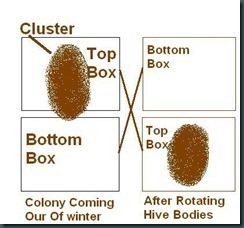overwintering bees
Overwintering Bees
Overwintering bees is an art. Very few beekeepers understand how to successfully overwinter honey bees.
1. Keep your colony's mite load less than 3 mites per 100 bees all year. Bees die in the winter from viruses spread by mites.
2. Keep a strong laying queen year round.
3. Feed protein in your sugar water during the fall dearth.
4. Raise an abundance of bees of winter physiology in the fall.
5. Allow ventilation, especially top insulation with our winter-bee-kind.
6. Use a wind block.
To learn more about overwintering bees, take our online course.
Depending on how cold it gets where you live, bees form a tight cluster to survive the winter. Here in Illinois it gets really cold. And this time of the year, it’s too cold to inspect our colonies. We can open them just for a minute to replace candy boards but for the most part the bees are on their own until late February.
Cold does not kill a healthy, populous colony. Usually beekeepers lose colonies during the winter from varroa mites, tracheal mites, nosema, pesticide build up in stored pollen or starvation.
So many beekeepers ask me what they can do to help their bees survive the winter. I’ve worked up an easy to remember acronym WINTERS:
Wipe out pest & diseases
Initiate protection against extreme climate conditions
New queen
Top Ventilation
Excluders and empty combs off
Restrict Opening to keep out mice
Sufficient Pollen & Honey
How does the typical hive overwinter? Bees make no effort to heat the inside of their hive like we heat our homes. We like every room to be warm. Bees, however, only produce heat from within the cluster. The cluster consumes honey and shiver to produce heat.
Bees begin to cluster when the outside temperature reaches 57 (f). Temperature of the outer surface of the winter cluster is just over 40 (f).
Within the center of the winter cluster the temperature is around 93 (f).
Never inspect a frame outside the hive until the temperature reaches 65 (f).
Colonies in the Midwest and north need around 4 frames of pollen for the winter, along with 60 pounds of honey.
Typically in northern climates the queen will reduces her laying in November through December but will start laying again shortly after winter solstice (December 21 or 22).
Winter bees have larger hypopharyngeal glands and more fat body reserves.
Bees can die in the winter if they become too filled with waste and cannot fly out and defecate. Winter bees can live up to 4-6 months.
Bees keep their humidity level at 40-50% in the summer hive and in the winter cluster.
The diameter of the winter cluster is around 14 inches at 57 (f) degrees, but 10 inches at -14 (f).
An outside temperature of 45 (f) degrees is most optimal for efficient use of stored resources.
A winter cluster is made up of an outside shell of bees around 3 inches thick that is very compressed. The bees heads are facing inward.
Within the center of the winter cluster, bees are less compressed and move around caring for brood. Bees vibrate their flight muscles to generate heat for the winter cluster.
Normally a colony forms a winter cluster below their stored honey and gradually move up near the available honey as winter progresses.
Smaller winter clusters consume more resources per bee than larger clusters.
Bees can identify temperature differences as small as 0.45 (f).
Very small clusters cannot survive temperatures 45 (f) and below.
The winter cluster prefers dark comb and usually avoids new comb.
Varroa mites, small hive beetles and trachea mites also survive within the warmth of the winter cluster.
Here’s some winter tips:
Never remove frames for inspection unless the temperature is at least 65 degrees.
Aster is not a good overwintering honey because it crystalizes fast and the bees rarely ripen it prior to winter. Crystallized honey in the winter can give the bees dysentery because it produces liquid as it separates and the bees are unable to take the cleansing flights they need.
Never give bees molasses, brown sugar or corn syrup as these contain complex carbohydrates and other compounds which the bees are unable to digest.
Bees prefer to overwinter on foundation that has been used in brood rearing and will rarely move onto new comb.
Here in the Midwest colonies need between 60-80 pounds of stored honey. Here are the weights of frames filled with honey:
DEEP FRAME 6 lbs
MEDIUM FRAME 3 lbs
SHALLOW FRAME 2.5 lbs
Colonies need 4 frames of pollen for winter.
If your bees need emergency feed, consider our Winter-Bee-Kind.
In The summer of 2011 we introduced our Winter-Bee-Kind after several years of studying overwintering hives. We could barely keep up with production they were in such demand. We still make them right here at Long Lane Honey Bee Farms but we've expanded our production methods to keep up with demand. So many beekeepers told us that these were the only thing that got their hives through the winter. This year, it's time for the 2014 production year. We even mix the sugar and pollen and right here and pour the candy into the Winter-Bee-Kinds. WHAT IS A WINTER-BEE-KIND? It is a one piece candy board that provides food, ventilation, upper insulation and an upper exit/entrance to help bees remain healthier during the winter. Someone said it insulates, ventilates and feed-i-lates. With the built in upper vent, you don't have to worry about snow covering up your hive's lower entrance. The bees can still go in and out through the top vent spacing. We avoid shipping Winter-Bee-Kinds in hot weather and start shipping each September-March. You can place our Winter-Bee-Kinds on your hive anytime, even in the winter. Because it goes on top of the hive in place of the inner cover, and you are NOT removing any frames, it can be placed on the hive in cold weather. Just do it fast. Open the top, remove the inner cover and place the candy side down and the vent slot toward the front of the hive and you're done. Click here to order your Winter-Bee-Kinds Some form of a candy board has been around for a long time. Beekeepers of long ago placed candy in their hives to provide enough food for their bees to survive the long months of winter. There are various mixtures and receipts for candy boards. Some are made with soft candy and some with hard candy. The end result is still the same. The bees will consume the sugar as they need it. We've always been concerned about the amount of condensation that can develop in the hive during the winter. The bees produce heat within their hive and as the temperature is very cold outside the hive, condensation will develop on the warm side, just above the bees on the inner cover or top cover. This condensation can accumulate and drop down onto the winter cluster of bees below. Bees can stay warm in the winter but they must remain dry. If this cold water drips down onto the bees, it can reduce their ability to keep their cluster warm. The insulation on our Winter-Bee-Kind helps reduce the excessive moisture and even puts some of that moisture to work, as it accumulates on the candy and makes it easy for the bees to consume the sugar. Thus, a Winter-Bee-Kind can help lessen two winter stresses, the lack of food and excessive moisture. We make our Winter-Bee-Kinds with sugar and a healthy amount of pollen powder. Many beekeepers make the mistake of only feeding their bees sugar in the winter, but the bees also need protein which they obtain from pollen. Our Winter-Bee-Kinds come with pollen mixed in with the sugar. Click here to order your Winter-Bee-Kind today. We recommend that you place candy boards on your hive any time between Oct-March.

